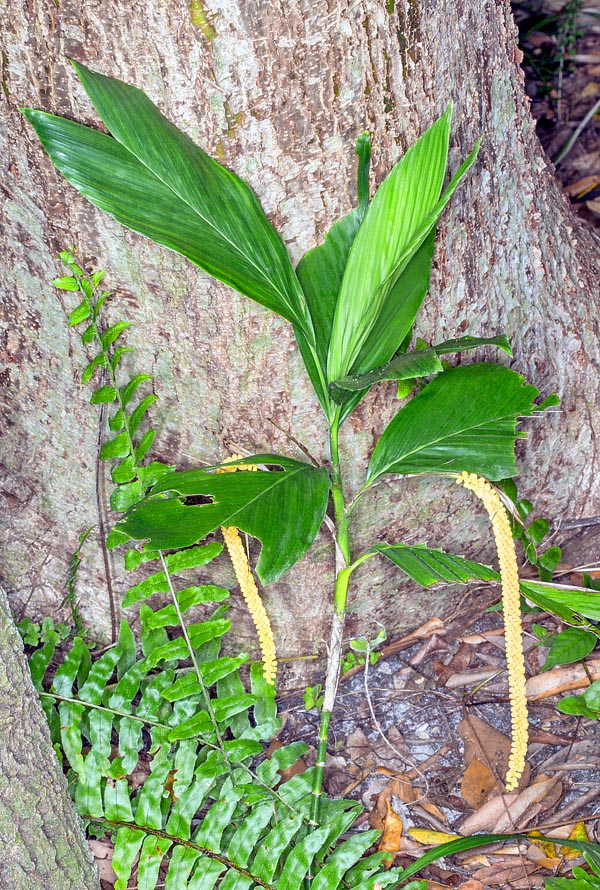Family : Arecaceae

Text © Pietro Puccio

English translation by Mario Beltramini
The species is native to Belize, Costa Rica, Guatemala, Honduras and Mexico (Chiapas, Oaxaca and Vera Cruz) where it lives in the underwood of the humid forests, on rocky soils mainly calcareous, up to 1000 m of altitude.
The name of the genus is the combination of the Geek adverb “χαμαί” (chamai) = on the ground, on the soil, and of the substantive “δωρέα” (doréa) = gift, the German botanist Carl Ludwig Willdenow (1765-1812), who created the genus in 1806, did not specify the exact meaning of the name. The specific name is the combination of the name of the genus Geonoma and of the Latin suffix “formis” = shaped like of obvious reference.
Common names: necklace palm, necklace Chamaedorea (English); capuca-capocha (Guatemala); pacaya (Honduras).

Native to Central America, Chamaedorea geonomiformis is a small solitary dioecious palm with stems even 2 m long of 0,5-1 cm of diameter. Male inflorescences have yellowish close flowers. Easy to grow © Giuseppe Mazza
The Chamaedorea geonomiformis H. Wendl. (1852) is a very variable dioecious species with solitary stem, erect or sloping, up to 2 m tall and of 0,5-1 cm of diameter, of green colour with the rings trace of the fallen leaves, spaced 1-2,5 cm, prominent, and adventitious roots at the base. The leaves, on a 2-12 cm long petiole, are simple, oblanceolate with bifid apex and slightly wavy to crenate margins, 15-30 cm long and 10-15 cm broad, coriaceous, of glossy intense green colour. The tubular foliar base, open obliquely at the apex, 4-10 cm long, wraps totally the stem for a length of 2-6 cm, persisting dry for long time.
Inflorescences between the leaves (interfoliar), often under the leaves in fruit, on a thin ascending peduncle, 10-20 cm long, initially green, then orange red.
The male inflorescences are usually ramified, with 2-6 drooping rachillae of pale yellow colour, rarely spike-like, 15-20 cm long, bearing several close flowers of yellowish colour, of about 4 mm of diameter.
Female inflorescences usually ramified, erect, with 2-3 rachillae, rarely spike-like, up to 15 cm long, initially of green colour, then orange red in fruit, with rather spaced flowers slightly sunken into the rachis, of about 2 mm of diameter, of yellow colour.
Globose fruits, of 0,8-1 cm of diameter, initially green, then bluish black when ripe, containing only one seed, globose, of about 0,7 cm of diameter.
It reproduces by seed placed in draining loam maintained humid at the temperature of 26-30 °C, with germination times starting from 2 to 3 months. Introduced in Europe by the second half of the XIX century, with the name of Chamaedorea geonomiformis as well as Chamaedorea tenella, has prompted immediate interest, as greenhouse plant and for the decoration of inner spaces, for its contained dimensions, the bright foliage and the ornamental inflorescences, interest that in the time has rather decreased due to the massive introduction of new ornamental species. In the mean time has increaed its use as plant for shady gardens, solitary or in group, in the tropical, subtropical climate zones as well as in the warm temperate ones where it can stand temperatures up to about -2 °C for short times. Of easy cultivation, it is not particular about the type of soil, provided draining and maintained constantly humid.
Synonyms: Chamaedorea humilis hort.; Chamaedorea fenestrata H.Wendl. (1854); Nunnezharia geonomiformis(H.Wendl.) Hook.f. (1874); Geonoma fenestrata (H.Wendl.) H.Wendl. (1878); Chamaedorea tenella H.Wendl. (1880); Nunnezharia tenella (H.Wendl.) Hook.f. (1881); Nunnezharia fenestrata (H.Wendl.) Kuntze (1891); Nunnezharia humilisKuntze (1891); Geonoma humilis auct. (1904).
→ For general notions about ARECACEAE please click here.
